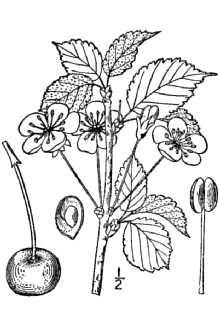
plants.usda.gov
Decription: Sweet cherry is an introduced fruit tree that has been naturalized from gardens and farms into the wild in eastern and midwestern Habitat: The settlers that lived in the mountains of Sweet cherry can grow in acid, neutral, and basic soils. It prefers average, medium wet, well-drained soils in full sun, such as roadsides like Other Facts: Sweet cherry originated in the area between the Black and Caspian seas of Cherries are susceptible to a large number of diseases and insect pests. Diseases include bacterial canker, rots, scab, crown gawl and powdery mildew. Insect pests include aphids, caterpillars, scale, and flies. Like all stone fruits, cherry flowers, leaves, and especially seeds and bark contain toxic compounds that produce hydrogen cyanide, which is toxic or lethal in large doses. It is readily detected by its bitter taste, often reminiscent of almonds. Children have been poisoned by chewing twigs, eating seeds, and making tea from leaves. Livestock have been killed from browsing its branches and leaves. The fruit of the sweet cherry can be cooked in pies and cakes, or used to make preserves. It can be eaten raw or cooked and may be bitter or sweet, depending on how ripe it is. If the fruit is very bitter, make sure not to swallow the seed, as it may contain high levels of cyanide, mentioned above. An edible gum can be obtained by wounding the bark. Although no specific reference has been found for this species, all members of the Prunus genus contain amydalin and prunasin, substances which break down in water to form hydrocyanic acid (cyanide or prussic acid), which is of course toxic or lethal in large doses. In small amounts, however, it has been considered therapeutic, particularly for cancer treatment, and has been used for this purpose since at least 25 BC. It can also stimulate respiration and improve digestion. Sweet cherry fruit stalks are an astringent, tonic and diuretic, the latter attribute thought to cure kidney diseases. A decoction is used in the treatment of cystitis, oedema, bronchial complaints, looseness of the bowels and anemia. In addition, an aromatic resin can be obtained by making small incisions in the trunk, which has been used as an inhalant in the treatment of persistent coughs. In References and Links: Grimm, William Carey. 2002. The Illustrated Book of Trees. Stackpole Books. Little, Elbert L. 1996. National Audubon Society Field Guide to North American Trees, Eastern Region. Alfred A. Knopf, Inc.; University of Georgia Horticulture Program - Cherries Further information can be found: Integrated Taxonomic Information System (ITIS) Report U.S. Department of Agriculture. Germplasm Resource Information Network database which is sponsored by the Agricultural Research Service, U.S. Department of Agriculture. PLANTS National Database, a website supported by the Natural Resource Conservation Service. |
Last updated: February 26, 2015
